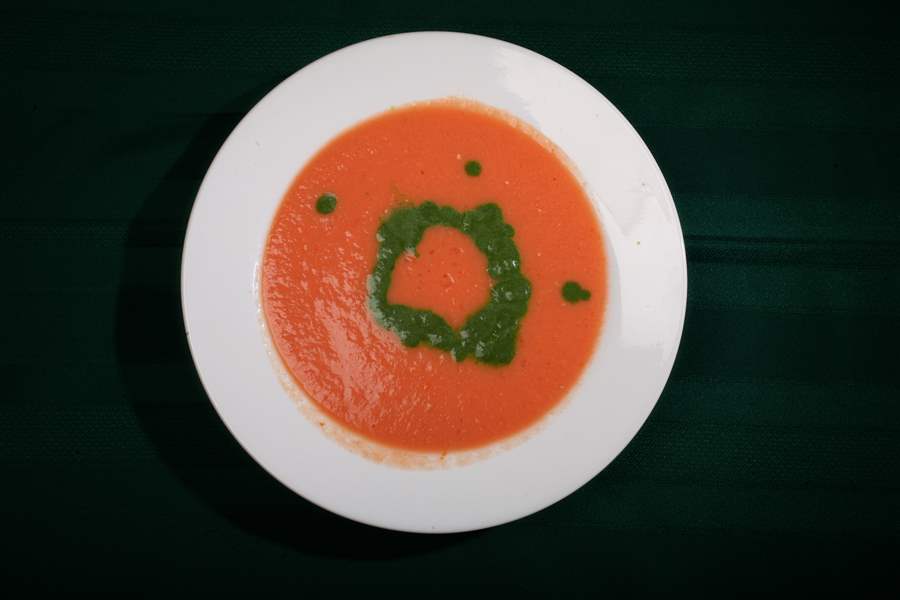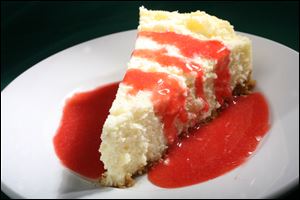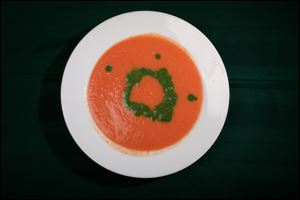
A chef's secret weapon: coulis
9/4/2012
Tomato soup with spinach coulis.
The Blade/Andy Morrison
Buy This Image

Cheesecake with strawberry coulis.
The waiter brings out your plate of seared scallops, and around the perfectly cooked, succulent seafood is an artfully arranged circle of bright green liquid.
You order a molten chocolate cake, and it arrives sitting in a pool of a sauce that is enticingly red. Or an impossibly flaky napoleon pastry comes criss-crossed with a sauce of vibrant blue.
The secret ingredient is a coulis, and it is one of a restaurant's best tricks to add flavor and flair to a dish. It is elegant and adds a visual verve -- making circles and dots out of a coulis (pronounced COO-lee) is most popular now, but a few years ago it was all about squiggles and pools.
While they look impressive on a restaurant's plate and add a bright splash of flavor to a dish, coulis are actually extremely easy to make at home. You can astonish your guests for very little effort.
As they are usually understood and used now, coulis are slightly thick but velvety smooth sauces made from pureed fruits or vegetables. The original, classical use of the term was a meat sauce that had been reduced three times; a method both time consuming and expensive.
Today's coulis are easier and cheaper, and can be used to add color and flavor to soup, to give visual appeal and a complementary taste to a main course, or to add one last kicker to a dessert. They are the equivalent of the cherry on top of a sundae -- and they can be used as a sauce on top of a sundae, too.

Tomato soup with spinach coulis.
Brian Hein, executive chef at the Hollywood Toledo Casino, said, "you don't have to be a pro to make a coulis. They're vibrant in color, generally. They add an aromatic punch to whatever you're making or producing or what you want to feature."
Because they are rarely made with starch or fat, he said, they are usually quite healthy, "a beautiful way to incorporate flavor or color," he said. Beyond that, they are fast and easy to make, and are always impressive, he said.
"You can put two different coulis on a plate, and with the featured item in the middle you can have three flavors on the plate. It makes the home cook look pretty savvy real quick," he said.
Coulis made from fruit are usually sweet (but not always) and are usually part of a dessert (but not always). Coulis made from a vegetable are usually savory. But not always.
For instance, James P. DeWan, a chef and culinary instructor writing in the Chicago Tribune, suggested serving a cucumber coulis drizzled around a lemon meringue pie or a raspberry coulis to accent slices of pork tenderloin.
Generally speaking, the softer a fruit or vegetable is, the less it needs to cook before being turned into a coulis. Soft berries, such as raspberries or strawberries, or very ripe fruit, do not need to be cooked at all. Spinach needs just to be wilted for a minute, while harder vegetables such as broccoli and asparagus need to be steamed, boiled or braised until they are tender before they can be turned into a sauce.
If you are braising them by cooking them in a small amount of liquid, you can add aromatics such as herbs, garlic or shallots to the liquid for extra flavor.
Technically, according to Mr. Hein, a coulis is a thickened vegetable or fruit sauce in which the item has been thickened with its own puree. Practically speaking, that means you end up, more or less, with the essence of the fruit or vegetable. You get the basic flavor -- often brought to the fore with lemon juice, sugar, and other flavor enhancers -- in a sauce form. Usually, the skins or seeds are strained out, leaving a simple, silken sauce.
I started out with the easiest possible recipe, for strawberry coulis. It took a total of five minutes from start to finish, and I had one eye on a baseball game while I was making it. I just pureed strawberries in a blender with water, lemon juice, and a dash of sugar. After pressing this puree through a fine-mesh strainer to remove the tiny, gritty strawberry seeds, I was left with a beautifully smooth, delicious, and not-too-sweet sauce that would be divine with poundcake, drizzled over cheesecake, or, as suggested by Driscoll's berries, served with a dish of spicy cumin chicken.
Nearly as easy, though requiring just a bit more physical effort, was raspberry coulis. This sauce is not blended; the soft berries are first forced through a regular strainer to puree them and then, if needed, through a fine-mesh strainer to catch the seeds (when I made it, the seeds were all filtered by the regular strainer). Raspberry is a natural accompaniment to chocolate, but the coulis could also be served with pork, as noted, or ham or even duck.
Tomatoes came into play with three recipes that I made. A tomato coulis would go great with many green vegetables, from artichokes to zucchini; its deep, round flavors come from olive oil, garlic, and basil. This particular coulis, from James Peterson's seminal book Sauces, requires no straining; it is just pureed, seeds and all. Meanwhile, following a recipe from Jacques Pepin, I made a marvelous chilled tomato soup with spinach coulis. In this case, almost paradoxically, the tomato seeds are captured when the soup part is strained through a food mill while the astonishingly bright green spinach coulis is merely pureed, with no straining.
Nothing could be simpler than that.
A third recipe with tomatoes was one of the few I made that needed to be cooked. A curried tomato coulis (Gourmet magazine recommended serving it with grilled scallops, but any white-fleshed fish would do) was an aromatic blend of tomatoes, curry powder, mustard seed, shallots, and a bit of balsamic vinegar. When pureed, it had a subtle warmth that would play off of naturally sweet meats such as pork.
The hardest part of making a mango coulis -- think of pairing it with coconut cake or a fruit tart or pan-seared halibut -- is separating the mango flesh from the peel. There are several ways to accomplish this, including cutting the mango in half, removing the seed, cutting cross-hatches in the flesh (like a tic-tac-toe board) all the way to the peel, turning it inside out, and then pulling or slicing the resulting cubes away from the peel.
But once you have it peeled, all you have to do is puree it with a little lime juice and orange juice, and then push the puree through a strainer to remove the fibers. That will leave you with a satiny smooth coulis.
According to Mr. Hein, "probably the most overused and brutalized coulis in the world is red pepper." But I like pepper coulis, so I decided to flaunt convention, slightly, to make a yellow pepper version.
I roasted yellow peppers directly over my stove's flame until the skin was blackened (you can also do it on a glass-top stove, in the oven, or even on a clean element of an electric stove). After they spent several minutes steaming in a paper bag, I rubbed off the blackened parts and removed the seeds. Then I blended the peppers with sherry vinegar, roasted garlic, olive oil, and a hint of spice.
The result? A smooth sauce with unexpected depth and a gorgeous yellow color.
The art of making a coulis is easy to master, and once you know how you can set your imagination free.
"They go great with just about anything," Mr. Hein said. "You can fire them up you can add any kind of flavor profile you want… It's wide open. Just about anything you can put your mind to you can make into a coulis."
Contact Daniel Neman at dneman@theblade.com or 419-724-6155.
Strawberry Coulis
2 cups quartered, hulled strawberries (about 12 ounces)
1/4 cup water
3 tablespoons sugar
1 tablespoon fresh lemon juice
Combine strawberries, water, sugar and lemon juice in blender. Puree until very smooth, then press through a fine mesh strainer to remove the seeds. Cover and refrigerate until cold. This coulis can be prepared one day ahead.
Yield: About 2 cups
Source: Smitten Kitten
Raspberry Coulis
2 cups raspberries
1/2 cup sugar
1/2 cup water
1-2 wedges lemon
Force raspberries through a strainer with a ladle or large wooden spoon. When using frozen raspberries, make sure they are completely thawed before straining. If there are any small seeds left, the coulis can be strained a second time through a fine-mesh strainer or chinois. Do not try to strain the raspberries through a chinois initially, as too much force may damage the fragile mesh screen.
Taste for sweetness. If it needs to be sweeter, boil the sugar and water together until the sugar has dissolved and the liquid is clear. Let cool. Add a spoonful or two of this simple syrup to the coulis, along with a few drops of lemon juice, and taste again. Continue adding simple syrup and lemon juice to the coulis until it achieves the balance you want.
This technique can be used for strawberries, blueberries, blackberries, or other soft berries.
Yield: 1/2- 3/4 cup
Source: Adapted from Sauces, by James Peterson
Tomato Coulis
4 medium fresh tomatoes, quartered
4 oil-packed sun-dried tomatoes, drained
1 garlic clove
3 tablespoons extra-virgin olive oil
5 basil leaves
Pinch of crushed red pepper
Kosher salt and freshly ground black pepper
In a blender, puree the fresh tomatoes with the drained sun-dried tomatoes, garlic, olive oil, basil, and crushed red pepper. Season with salt and black pepper. Refrigerate until ready to serve. Serve with braised or grilled artichokes or other green vegetables.
Yield: About 3-4 cups
Source: Food & Wine
Mango Coulis
2 mangos, very ripe
1 teaspoon lime juice
2 teaspoon orange juice
Peel the mangos and cut the flesh away from the skin (cut the mangos in half, remove the pit, cross-score the flesh -- make a large tic-tac-toe pattern -- turn the halves inside out, and cut away the cubes of mango fruit). Place the mangos in a processor with the lime and orange juice. Puree, then strain to remove stringy fibers. Bring the strained puree to a quick boil and remove from heat. Adjust the flavor and consistency to your taste with the addition of more lime or orange juice. Store covered in the refrigerator.
Yield: About 2 cups
Source: Louisiana Culinary Institute
Roasted Yellow Pepper Coulis
3 large yellow bell peppers
Vegetable oil
3 garlic cloves, unpeeled
3 tablespoons extra-virgin olive oil
1 1/2 tablespoon sherry vinegar
Pinch cayenne
Pinch cumin
Salt and ground pepper
Chicken broth, as needed, optional
Rub the peppers with vegetable oil; place directly over flame on open burner or glass-top or electric element of stove. Turn the peppers occasionally, blackening them thoroughly on all sides. When peppers are nearly all black, place in sealed paper bag or wrap in plastic; set aside to cool. Peel to remove all blackened skin. Pull peppers apart; remove and discard seeds and pith. Slice peppers into rough strips.
Meanwhile, place garlic in a small saucepan over medium heat. When skin turns black, flip to another side; cook until garlic is soft, 7-8 minutes total. Set garlic aside to cool; peel cloves.
Combine peppers, garlic and remaining ingredients (except broth) in a blender; pulse until pureed. If puree is too thick, thin with broth. Finished sauce should have consistency of a light tomato sauce.
Yield: About 2 cups
Source: Chicago Tribune, by James P. DeWan
Curried Tomato Coulis
2 large shallots, sliced thin
2 tablespoons olive oil
1 teaspoon mustard seeds
1 1/2 teaspoons curry powder
1/2 teaspoon sugar
6 plum tomatoes, seeded and chopped
2 teaspoons balsamic vinegar
In a skillet, cook the shallots in the olive oil over moderate heat, stirring, until they are softened. Stir in the mustard seeds and the curry powder, and cook the mixture, stirring, for 1 minute. Stir in the sugar, the tomatoes, and salt and pepper to taste and cook the mixture, stirring, for 2 minutes, or until the tomatoes begin to release their juices. Stir in the balsamic vinegar. Puree in a blender.
Serve warm with sauteed or grilled scallops, or other white fish, about 3/4 pound for two.
Yield: 2 servings
Source: Gourmet magazine
Silky Tomato Soup with Spinach Coulis
Tomato Soup
3 pounds ripe tomatoes
1 sweet onion, cut into 1/4-inch pieces
2 large garlic cloves
1/4 jalapeno pepper, or less
3/4 teaspoon salt
2 tablespoons good olive oil
1/4 teaspoon Tabasco, or less
Spinach Coulis
3 cups spinach leaves, loosely packed
1/4 cup oil (mixture of olive and canola)
1/4 teaspoon salt
1/4 cup water
For the tomato soup: Cut the tomatoes into 2- to 3-inch chunks. Finely puree the tomatoes, onion, garlic, jalapeno (if using), salt, and olive oil in a blender or food processor. Push the puree through a food mill fitted with the fine screen, then add enough Tabasco to suit your taste, if desired. Refrigerate until cool
For the spinach coulis: Pick out and discard any damaged leaves of spinach. Seal the leaves in a microwavable container, and microwave on high for 1 1/2 minutes. Transfer the spinach to a blender. Add the oil, salt, and water, and process for about 1 minute, stopping to scrape down the sides with a rubber spatula if necessary. When smooth, transfer the puree to a bottle or jar, cover tightly, and refrigerate.
To serve, ladle out 1 1/2 cups soup per person. Garnish each bowl with 1-2 tablespoons of spinach coulis.
Yield: 4 servings
Source: Fast Food My Way, by Jacques Pepin.